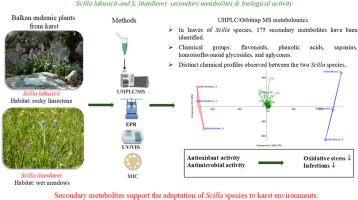Secondary metabolites and biochemical adaptations of Scilla lakusicii and S. litardierei to karst environments: a metabolomic perspective
IF 2
4区 生物学
Q4 BIOCHEMISTRY & MOLECULAR BIOLOGY
引用次数: 0
Abstract
Comprehensive metabolomic analysis on the leaf extracts of Scilla lakusicii and S. litardierei revealed the presence of 175 secondary metabolites. The identified compounds were categorized into several groups based on their chemical structures: hydroxybenzoic acids, hydroxycinnamic acids, saponins, flavonoid glycosides, flavonoid aglycones, homoisoflavonoid glycosides, homoisoflavonoid aglycones, and other metabolites. Saponins were the most abundant in both species, with some detected for the first time in plant tissues. Regarding volatile compounds, extracts from both species contained α- and β-pinene, neophytadiene, and phytol. S. litardierei showed a higher capacity to neutralize DPPH radicals, while S. lakusicii was more effective in scavenging hydroxyl radicals and reducing Fe3+ and Cu2+ ions. Both species exhibited similar capacities for H2O2 removal and Fe chelation. In terms of anticandidal activity, S. lakusicii was particularly effective against Candida glabrata and resistant C. auris, the latter of which showed no response to the standard drug ketoconazole. S. litardierei was more effective against C. glabrata. Both extracts demonstrated significant efficacy against resistant Escherichia coli in terms of antibacterial activity, while S. litardierei proved more effective against resistant Pseudomonas aeruginosa. Overall, leaf extracts of both Scilla species displayed significant antioxidant and antimicrobial activity, attributable to their specific chemical composition. The richness of secondary metabolites and pronounced biological activity enable the adaptation of these Scilla species to karst environments.

湖泊香茅和利氏香茅次生代谢物及其对喀斯特环境的生化适应:代谢组学视角
综合代谢组学分析发现,湖湘香薷叶提取物中存在175种次生代谢物。根据化合物的化学结构将其分为羟基苯甲酸类、羟基肉桂酸类、皂苷类、类黄酮苷类、类黄酮苷类、同异黄酮苷类、同异黄酮苷类和其他代谢物。两种植物中皂苷含量最高,有些是首次在植物组织中检测到。在挥发性化合物方面,两种植物提取物均含有α-蒎烯、β-蒎烯、新叶二烯和叶绿醇。李氏木耳对DPPH自由基的中和能力较强,而木耳对羟基自由基的清除能力较强,对Fe3+和Cu2+离子的还原能力较强。两个物种对H2O2的去除能力和铁螯合能力相似。在抗念珠菌活性方面,S. lakusicii对光念珠菌(Candida glabrata)和耐药金黄色葡萄球菌(C. auris)特别有效,后者对标准药物酮康唑无反应。对光斑夜蛾的杀伤效果较好。两种提取物对耐药大肠杆菌均表现出显著的抗菌活性,而利塔蒂耶氏菌对耐药铜绿假单胞菌的抗菌活性更强。综上所述,由于其特定的化学成分,两种Scilla植物的叶提取物均表现出显著的抗氧化和抗菌活性。丰富的次生代谢物和显著的生物活性使这些Scilla物种能够适应喀斯特环境。
本文章由计算机程序翻译,如有差异,请以英文原文为准。
求助全文
约1分钟内获得全文
求助全文
来源期刊

Biochemical Systematics and Ecology
生物-进化生物学
CiteScore
3.00
自引率
12.50%
发文量
147
审稿时长
43 days
期刊介绍:
Biochemical Systematics and Ecology is devoted to the publication of original papers and reviews, both submitted and invited, in two subject areas: I) the application of biochemistry to problems relating to systematic biology of organisms (biochemical systematics); II) the role of biochemistry in interactions between organisms or between an organism and its environment (biochemical ecology).
In the Biochemical Systematics subject area, comparative studies of the distribution of (secondary) metabolites within a wider taxon (e.g. genus or family) are welcome. Comparative studies, encompassing multiple accessions of each of the taxa within their distribution are particularly encouraged. Welcome are also studies combining classical chemosystematic studies (such as comparative HPLC-MS or GC-MS investigations) with (macro-) molecular phylogenetic studies. Studies that involve the comparative use of compounds to help differentiate among species such as adulterants or substitutes that illustrate the applied use of chemosystematics are welcome. In contrast, studies solely employing macromolecular phylogenetic techniques (gene sequences, RAPD studies etc.) will be considered out of scope. Discouraged are manuscripts that report known or new compounds from a single source taxon without addressing a systematic hypothesis. Also considered out of scope are studies using outdated and hard to reproduce macromolecular techniques such as RAPDs in combination with standard chemosystematic techniques such as GC-FID and GC-MS.
 求助内容:
求助内容: 应助结果提醒方式:
应助结果提醒方式:


